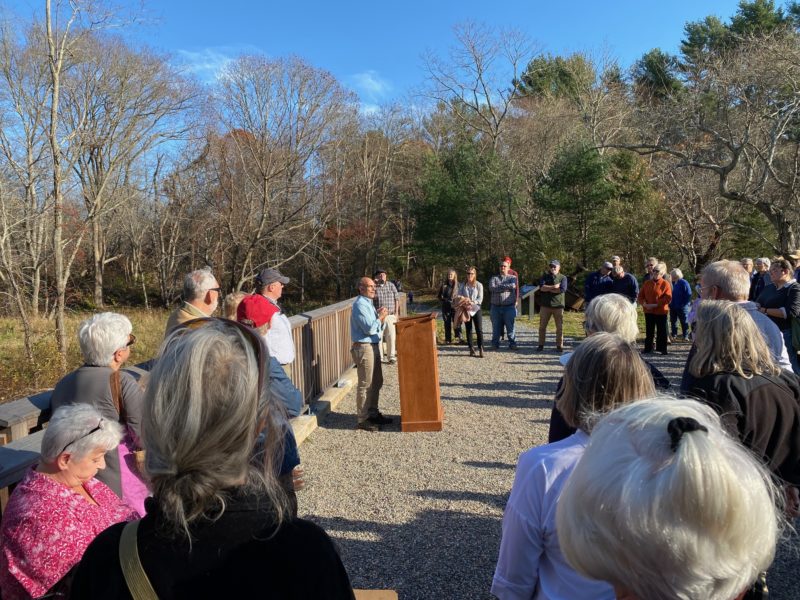Coalition celebrates grand opening of Weweantic River Reserve at Horseshoe Mill in Wareham
The Buzzards Bay Coalition welcomed State Representative Susan Williams Gifford; Wareham Select Board Chair, Judith Whiteside; state agency partners; and the public to celebrate the opening of the Weweantic River Reserve at Horseshoe Mill in Wareham, a beautiful new park and natural area open to everyone.
The Coalition purchased Horseshoe Mill in 2012, a former mill site with a decrepit dam, to protect the property from development, improve public access, and enable restoration of this important stretch of the river for its high natural resource values. Once a large, industrial site for manufacturing nails and horseshoes, the property has been transformed into a public reserve to improve river health, and offer canoe launches and improved trails for people to explore and enjoy the river.
The Weweantic is the largest freshwater river that flows to Buzzards Bay, and rich populations of fish, plants and other wildlife call the Weweantic River home. Prior to the project, migratory fish like river herring were blocked by the crumbling remnants of the mill dam preventing them from accessing upstream spawning habitat. The recently completed restoration, which included the removal of the dam, allows the migrating fish to freely swim upstream to access more than three miles of freshwater spawning grounds.
“Old dams like the one that was at this site create all sorts of problems for fish and wildlife that depend on the rivers flowing into the Bay,” said Brendan Annett, Vice President for Watershed Protection at the Coalition. “Removing this dam has immediately improved the natural functions of the Weweantic, undone many years of environmental damage and already begun to bring the river back to life,” Annett said.
The removal of the Horseshoe Dam allows for the Weweantic to revert to an ecosystem similar to the conditions that once existed, before dams were constructed at this site, more than two centuries ago. The dam was at the river’s head-of-tide, where salt water from the daily tides of the Bay meet freshwaters flowing from the river. With its headwaters in Carver and Middleborough, the Weweantic River contributes approximately 20% of freshwater inputs to Buzzards Bay. The ecosystems that form at these places where freshwater meet the salty Bay are home to plants that are adapted to these unique estuarine habitats. With flow of the tides restored to the area upstream of the former dam, plant species that were once restricted to downstream areas, are now re-establishing at this prime new habitat. These marsh plants are restoring rapidly, thanks in part to seeds that have been long buried in the sediments, but now have favorable conditions helping the plant community to recover.
The restoration of this natural flow also strengthens this river system against climate change, by providing room for brackish ecosystems to move upstream as waters warm and sea levels rise.
Significant funding for the project came from the Bouchard 120 Natural Resource Damage Trustee Council, a federal-state entity comprised of the Commonwealth of Massachusetts, the U.S. Fish and Wildlife Service, the National Oceanic and Atmospheric Administration, and the State of Rhode Island. The funds used for the Weweantic River restoration helped to address shoreline and aquatic resource injuries resulting from the 2003 Buzzards Bay oil spill. In addition, the National Fish and Wildlife Foundation, Massachusetts Environmental Trust, MA Department of Conservation & Recreation’s Trails Program, and MA Division of Marine Fisheries’ Recreational Fishing Development Fund also contributed funding to the project.
“The Coalition’s project leadership combined with NOAA and Trustee partners’ expertise and funding have led to reopening more than three miles of river for herring and other migratory fish,” said Carrie Selberg Robinson, Director of NOAA’s Office of Habitat Conservation, who noted this is a key project out of more than 25 restoring resources impacted by the 2003 Bouchard Barge 120 oil spill. “Now that the Weweantic River is flowing naturally, 90 acres of coastal wetlands are rebuilding, and increasing resilience against sea level rise and storms.”
“The Bouchard B-120 oil spill devastated natural resources in Buzzards Bay,” said Massachusetts Department of Environmental Protection Acting Deputy Commissioner for Policy and Planning, Paul Locke. “The Commonwealth is thrilled that settlement funds from the spill were used to support this important dam removal project that has tremendous ecological benefit to migratory fish and other aquatic life and also improves public access and climate change resiliency.”
The Coalition previously completed a similar, successful restoration project at The Sawmill on the Acushnet River. There, the Coalition and its partners restored fish passage and natural river banks while also installing trails and a canoe launch.